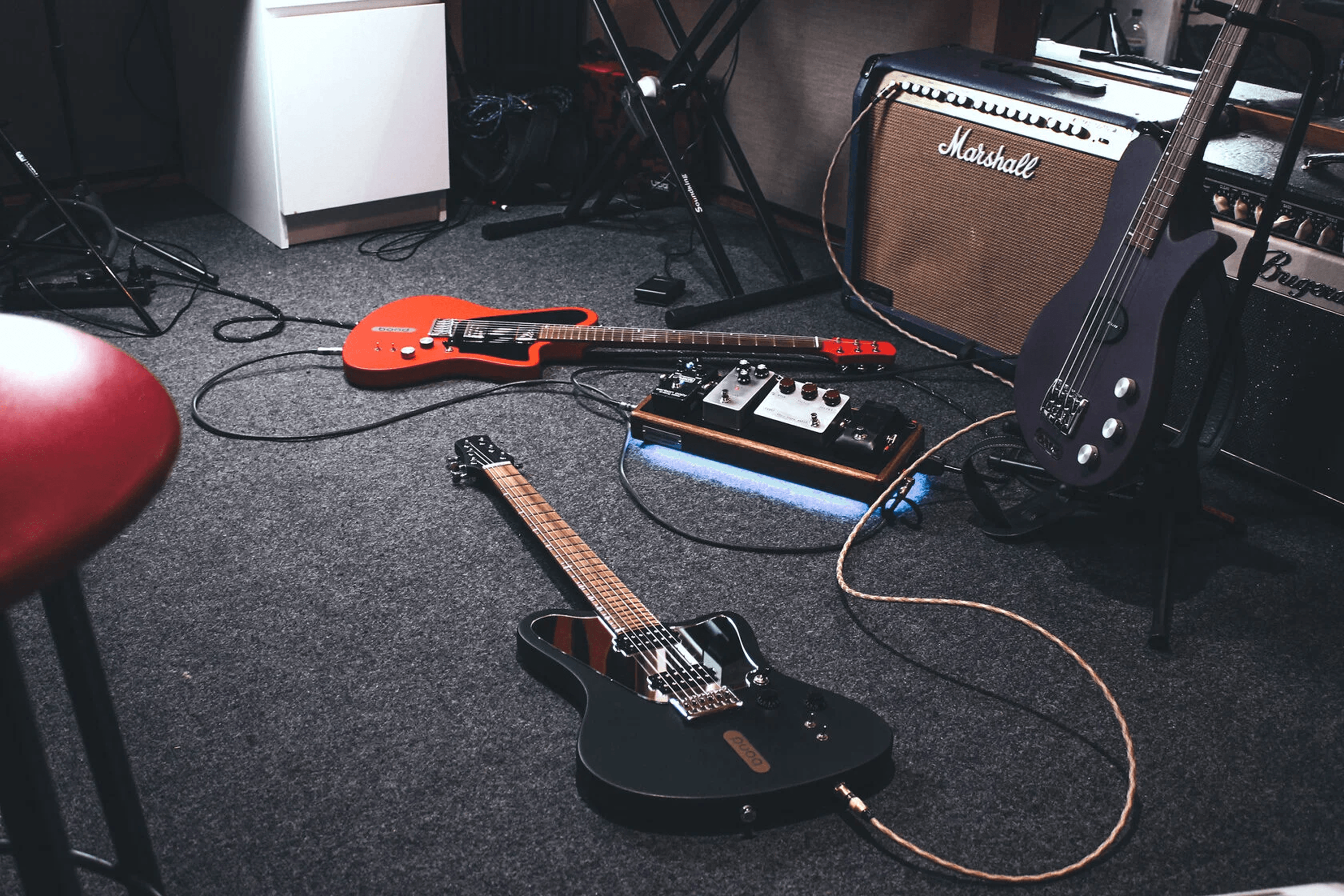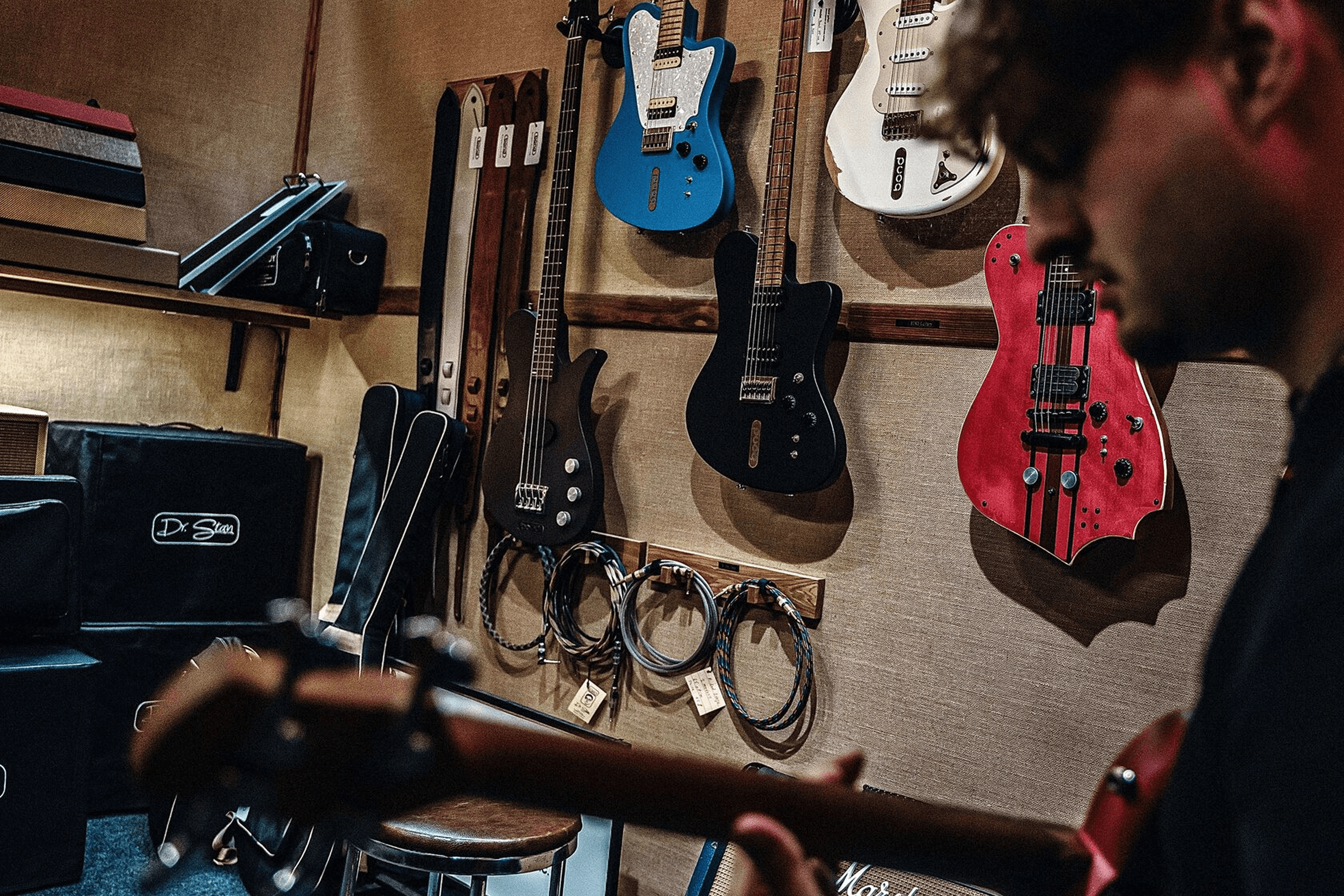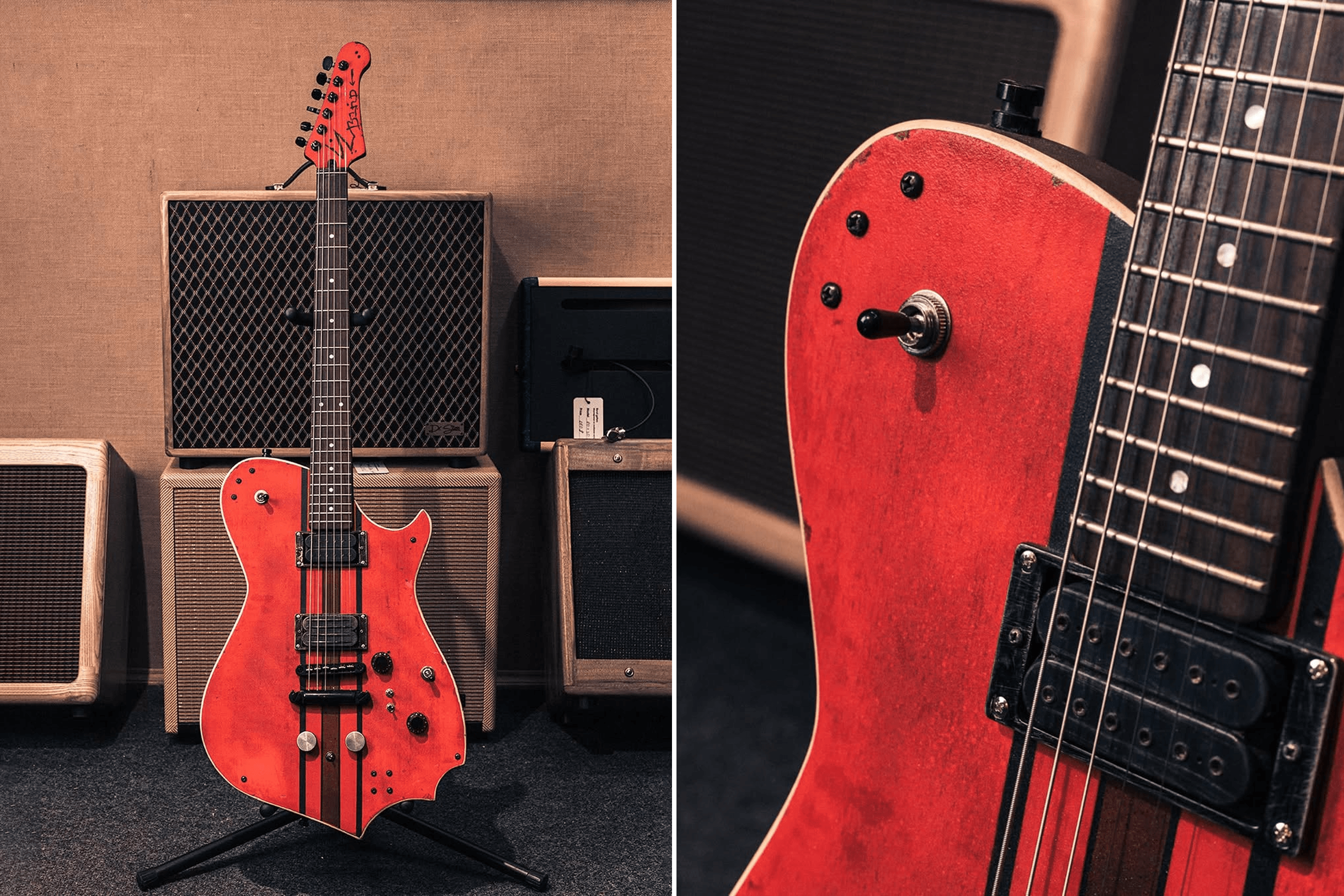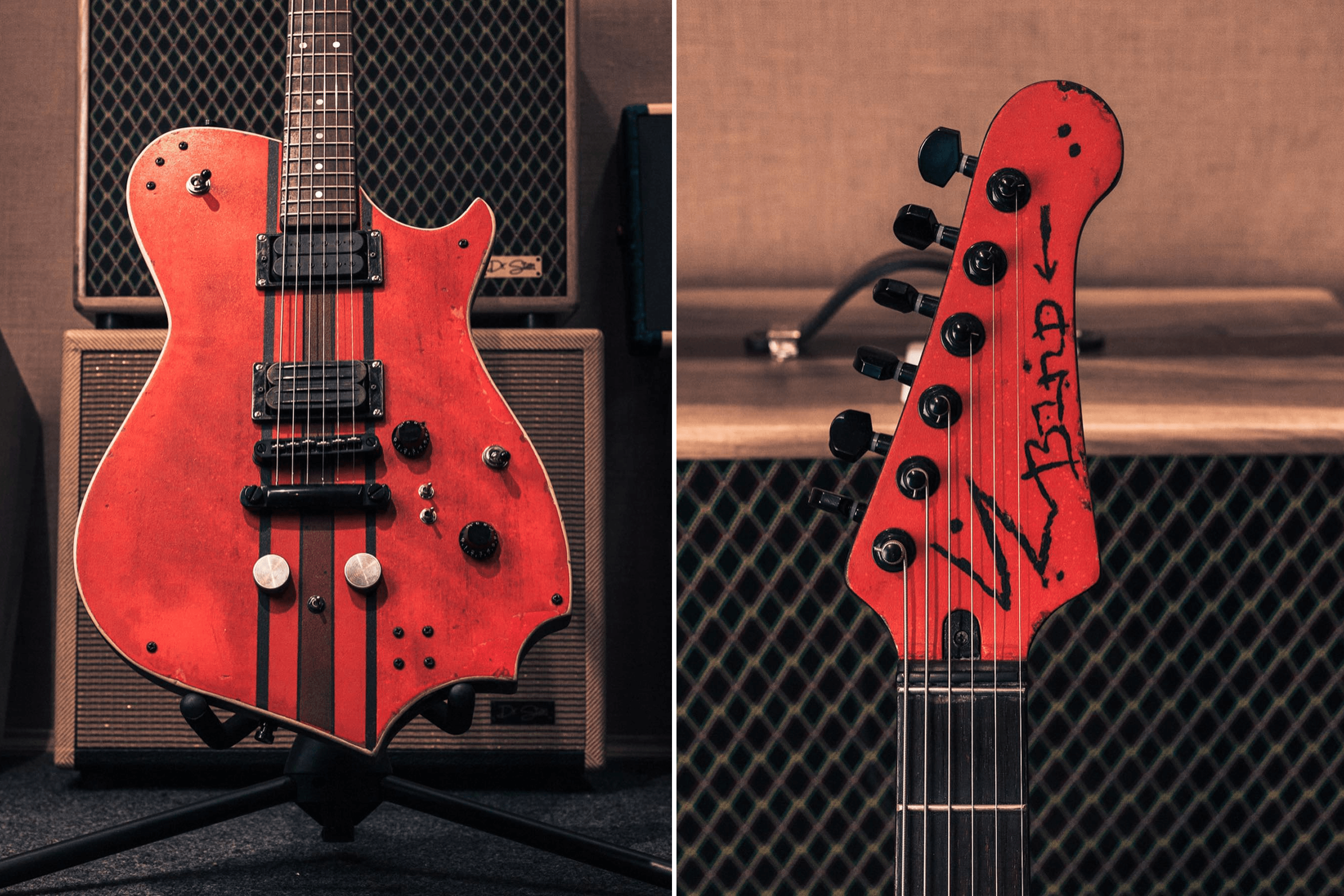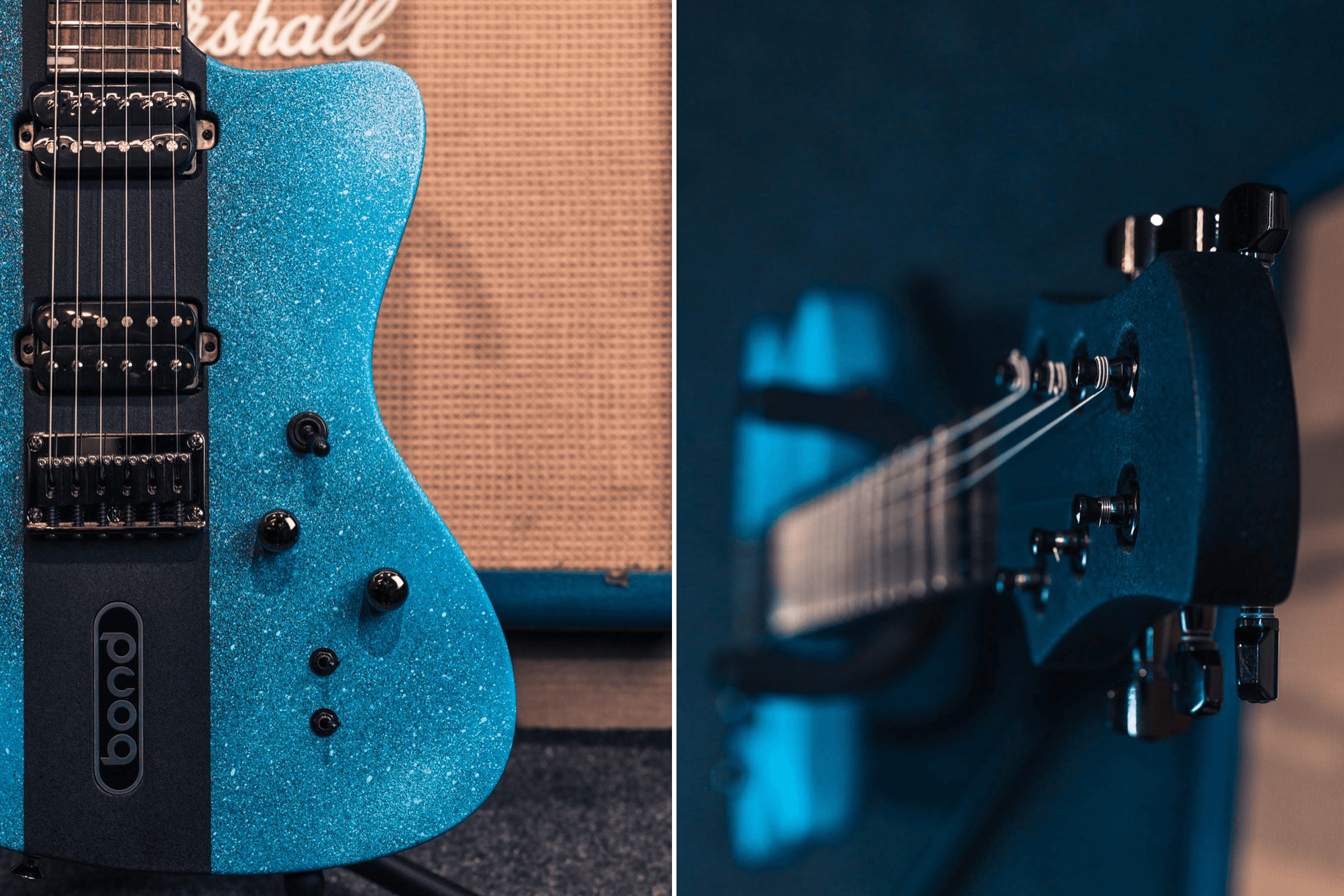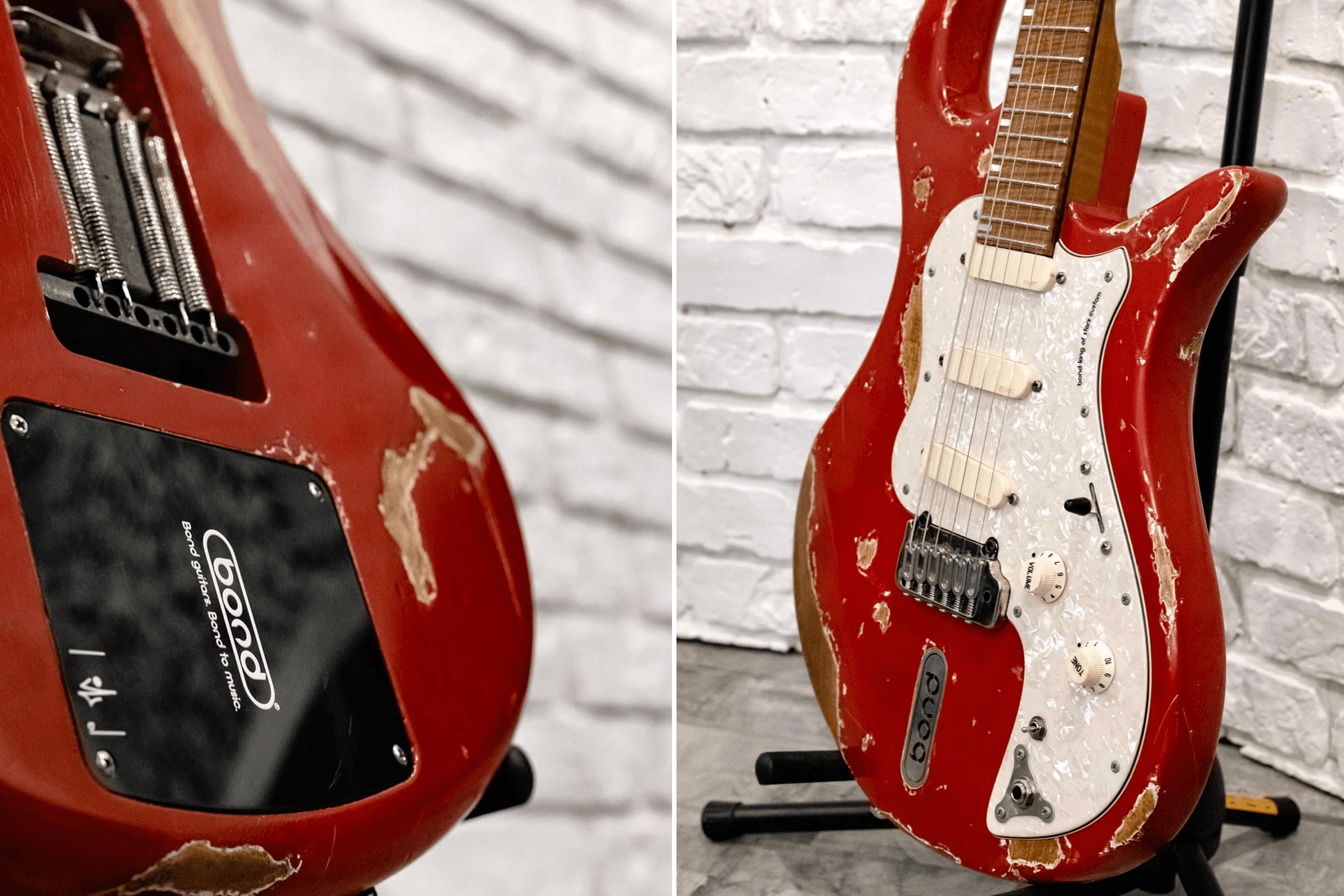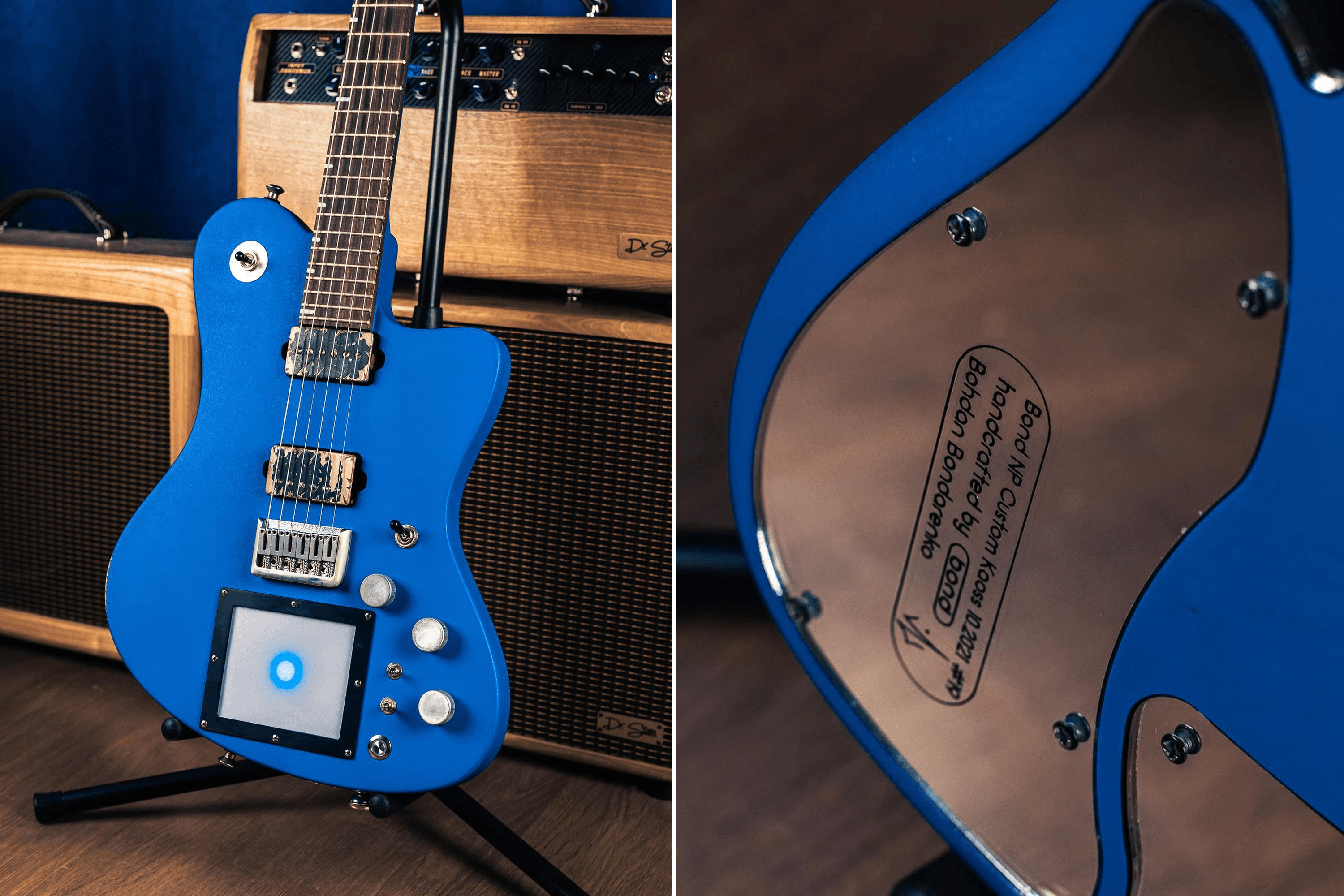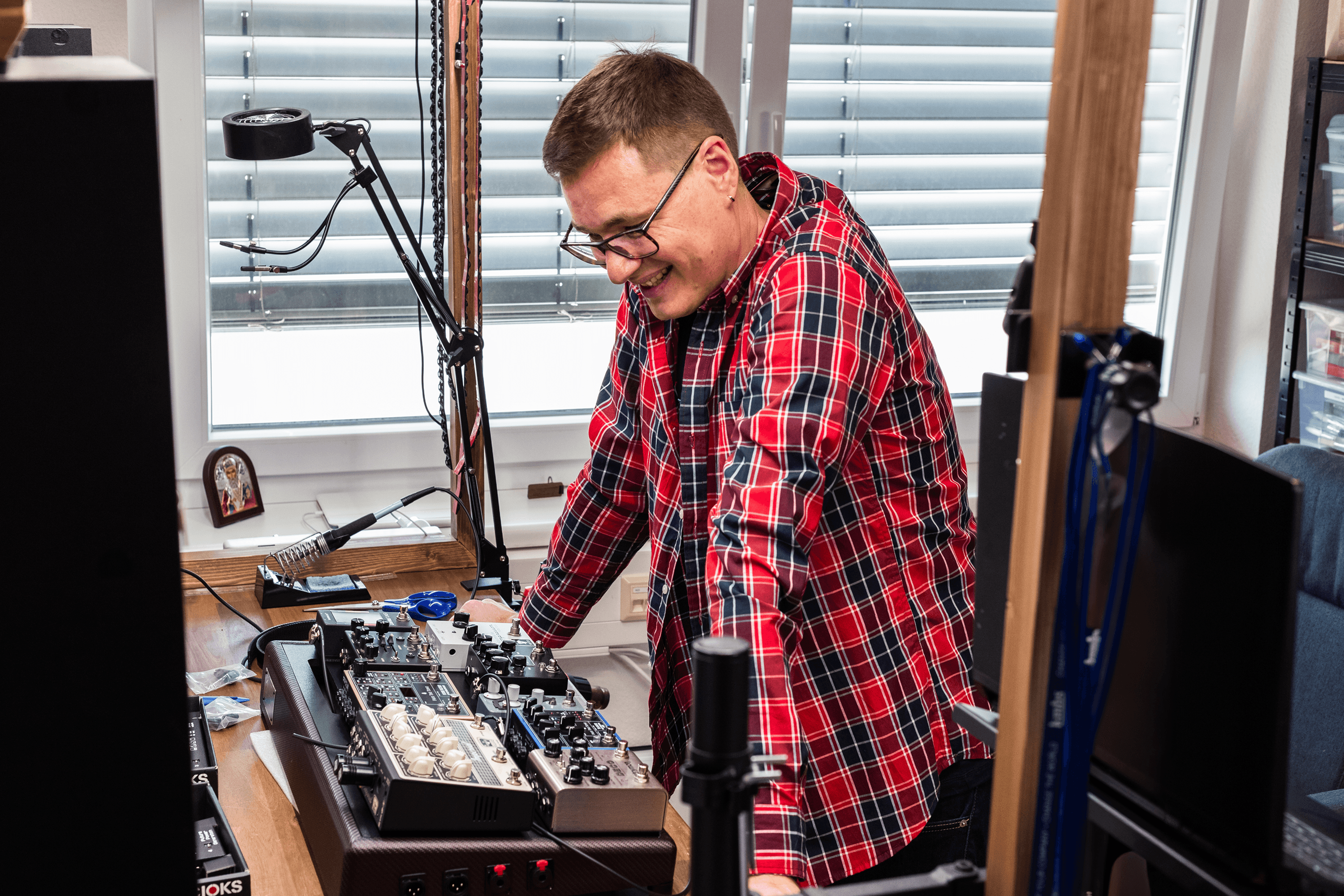Bohdan Bondarenko, a Kyiv native, fell in love with law back in high school. He enrolled in a financial-law lyceum and later in Taras Shevchenko National University of Kyiv, where he earned a PhD and spent five years teaching in the Department of Theory and Philosophy of Law at his alma mater. But Bohdan led a parallel life: he was passionate about music, played various guitars, and taught in private music schools. From the age of 18, Bohdan began making guitars by hand.
Ten years later, in 2019, he founded the Bond Guitars brand, which now produces about 15 custom guitars a year for clients in the EU, the U.S., and Ukraine. Their guitars are being played by bloggers with millions of followers. Eventually, Bohdan left the legal field and moved to Vienna. Now he works exclusively on Bond Guitars, together with his wife — a lawyer who manages the paperwork, prepares the brand for exhibitions, and contributes to content creation. Meanwhile, three professional luthiers and workshops remain in Kyiv. Bond Guitars is currently the only Ukrainian brand accepted into the European Guitar Builders Guild, representing Ukrainian craftsmanship at Guitar Summit in Mannheim, Germany.
YBBP journalist Mila Shevchuk asked Bohdan Bondarenko about the charitable Support Ukraine guitar series, demanding customers, and how a Ukrainian brand is creating its own trends in the music industry.
How did you move from teaching law to music and guitars?
As a teenager, I became interested in music. Once, on MTV, I saw an incredible music video by the British band Muse. Their frontman, Matthew Bellamy, had an unusual and interesting guitar. It impressed me so much that it changed my life. I realized that I wanted to pursue this path [guitar-making]. But in fact, this was my parallel life: I was also a teacher of acoustic, electric, and bass guitar. I bought my first guitar by breaking open my childhood piggy bank. Overall, I have been playing guitar for 18 years, seven of which I spent teaching in private schools in Kyiv, playing in bands, participating in festivals, and composing music. Even at the university where I worked in the law department, I founded a music studio for the student council.
But making guitars isn’t just about a love of music. Do you do the drawings, design, calculations, and technical work yourself?
Yes. My passion for guitars merged with a passion for drawings. When I was small, instead of children’s drawings, I made black-and-white schematics with notes for trains, cranes, and boats. Now I do it for guitars: drawings for production and a visual render for the client. When the client places an order, they can see what the result will look like.
When and how did your own company start?
I started researching the topic. It turned out that the guitars used by Muse’s frontman, Matthew Bellamy, were made by hand by an English luthier. They couldn’t be bought in a store, and it was even impossible to order one from the luthier. They were completely exclusive, one-of-a-kind instruments. This motivated me to figure out how they were made. In 2009, I made my first guitar for myself, and then friends started ordering. From 2011 to 2012, I sold guitars for $500 to $700 on OLX.
When and how did your own company come about?
In 2019, together with a team, I founded Bond Guitars. There were and still are six of us: my wife and I in Vienna, and in Kyiv, three luthiers and a woman who manages social media. At the beginning, orders ranged from $700 to $1,000, and later we moved to a higher-end market. The business led to my wife and me eventually settling in Vienna. I realized that we could expand geographically and establish a new hub in the EU, register the business, open a showroom, and work directly with clients from here. At the time we announced the brand, we were a company operating domestically with few international orders. The full-scale invasion changed that. International interest in Ukraine emerged. The market situation also changed: Ukrainian musicians weren’t really thinking about guitars, while abroad, on the contrary, people wanted to try Ukrainian products.
Why the name: Bond Guitars?
Until 2019, I called the guitars B.Bond — Bohdan Bondarenko. After that, the concept of the slogan Bond to Music emerged — the idea that our products are a connection to music. Because for some, music is a way to make easy money, generate tracks with artificial intelligence and sell them, or engage in superficial show business rather than creating art.
At the beginning, you were making guitars by yourself. When did you assemble a team?
When we registered the trademark in Ukraine. I’m a lawyer, and so is my wife, so we did everything properly from the start. Since the company announcement, the team has changed slightly, but since the invasion, we have kept the same lineup. I am the founder and Head Luthier, meaning the chief guitar maker and designer. The luthiers work in Kyiv. My wife handles organization, some legal matters, and helps prepare for exhibitions.
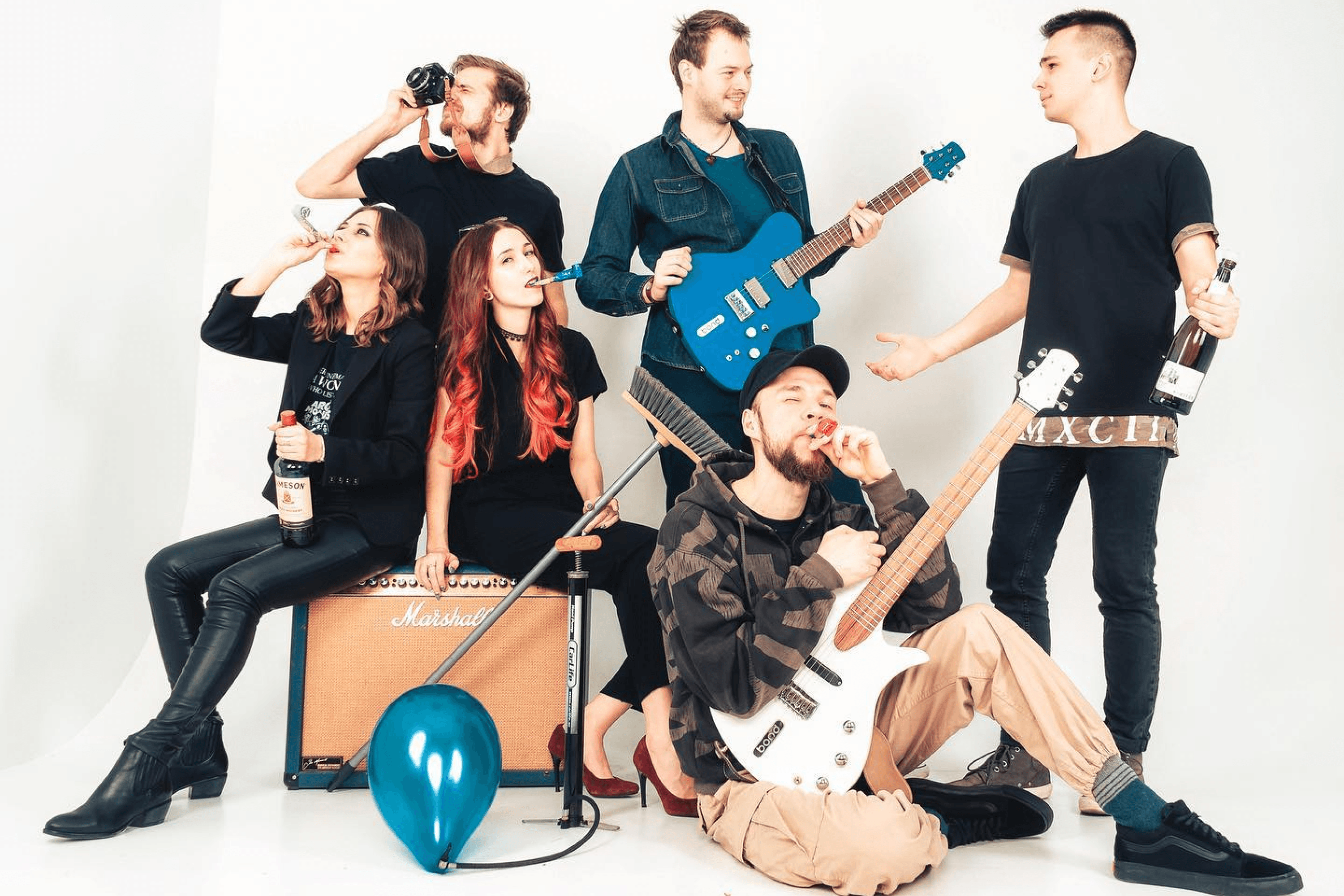
Where did you make your first guitars? You need a workshop for that, right?
For the first ten years, I worked in a personal workshop I set up in my parents’ small house in the Kyiv region.
Does making guitars require separate spaces for different tasks?
Before moving, I had a proper space in a remote district of Kyiv: three floors, a workshop, and part of the production, with different areas for different operations. There was also a guitar showroom for clients and photo shoots, which I moved to Austria. Now our showroom in Vienna is about 30 square meters, roughly one and a half rooms.
The workshops in Kyiv constantly faced incidents: sometimes a raider takeover, and during the full-scale invasion, Russian sabotage groups blocked the workshop, and our security company abandoned us. During Russian attacks on Ukrainian infrastructure and blackouts, the wood began to rot, devices rusted, and the workshop also came under shelling by Russians. We constantly invested money and rebuilt the workshops. Eventually, we spread production across the team members’ workshops.
How does the process work, and what is your role in making the guitars?
The process starts with me. I create, so to speak, the overall plan and design of the guitar, and order templates cut very precisely using laser technology. We have several workshops in Kyiv, where the woodwork is done first, then refined, painted, and the frets installed. Usually after that, the guitar is sent to me in Vienna so I can carry out all the final work, prepare it, and deliver it to the client.
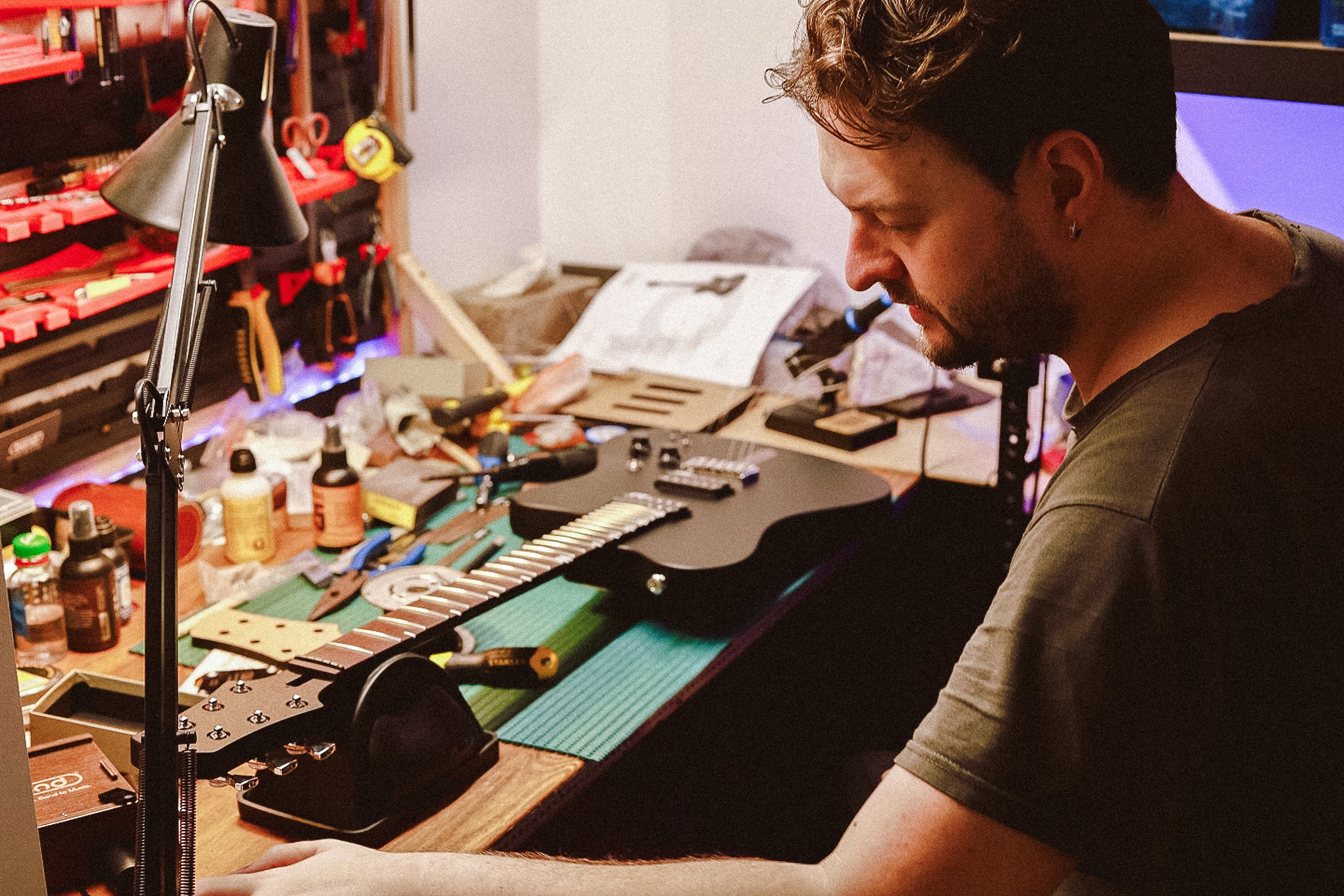
Who physically makes the guitar bodies and parts?
There is a well-known Ukrainian drummer from the iconic heavy metal band Komu Vnyz, Yevhen Razin. He is a recognized guitar craftsman, handling our painting and fret installation. He works with his assistant, Taras, who is a wood specialist. There is also a well-known Ukrainian luthier, Oleksii Grankin, who makes necks and uses CNC technology, precise laser cutting, and composite materials.
How long does it take to make a single guitar?
At least three to four months. It depends on whether it is a serial model we have made before or a custom order with unique features. Recently, we made a very unusual bass guitar for a client from the U.S. with through-holes. Or we were commissioned to make a guitar with a guitar effect, a pedal, built directly into the body, which can be controlled with the right hand. Usually, guitar effects are on the floor and operated with the foot. This guitar has been in production for just over four months.
Who are your main clients today?
There are three categories.
- The first is Ukrainian musicians, like Misha Krupin from the band Corruption.
The second category is social media influencers. In our case, these are female guitarists popular on social media. We became known thanks to the Odessa-based blogger Tasha S. She had 30,000 Instagram followers when we first started making guitars for her; now she has 2 million, plus around 6 million on TikTok. She is likely the most popular blogger-guitarist. There is also the very well-known Ukrainian bass guitarist Kateryna from the band Driedsugar, for whom we make bass guitars.
- The third category of clients is musicians from abroad who use the instruments daily, because they are professional musicians with many concerts and studio recordings. One example is William Dowell, the bassist of the Zak Salt Band from the United States.
How did musicians from around the world learn about your company? Did you advertise?
It’s an interesting question. Most people found out about us after the limited-edition charitable Support Ukraine collection of six instruments. We made the guitar bodies in the colors of the Ukrainian flag and crafted them in the Hard Relic style, like a guitar that has been played for 70 years, very worn with scratches and imperfections. For the guitar headstocks, we used a metal plate from a United 24 bracelet made from the last batch of steel from the Azovstal plant. The idea was profound: it reflected the state of the Ukrainian people after Russia’s invasion. This resonated with the international guitar community, and the entire collection was purchased by guitarists from the U.S. We donated 60% of the proceeds to funds supporting the Ukrainian Armed Forces, covering only our own specific costs. We still donate a portion of our income to such causes, but we do not announce it.
It was this collection that brought us attention in global publications and led to an invitation to participate in the Guitar Summit in Germany. They say it’s the biggest guitar event in Europe, but in fact, it’s the largest guitar event in the world. Only the NAMM Show in the U.S. is bigger, but it is generally a music event, not specifically a guitar one.

How do clients find you?
Mostly through Instagram and community recommendations, and many people know us thanks to our blogger clients.
What are common client requests? Are there any popular styles or trends?
Sometimes we make vintage guitars, using classical old techniques and materials that date back to the 1950s. Other times, by contrast, clients order very avant-garde Modern, or something ultra-modern and unusual.
Are there challenges with clients in terms of payment or demands?
With clients, it’s usually great, because these are people who have come a long way in their passion for guitars. Most start with budget instruments. After that, every guitarist goes through a Fender or Gibson era, the two most famous companies — though they are mass-produced. But yes, occasionally someone is very particular and may demand the smallest details: spotting a tiny flaw on the finish and wanting us to redo the entire coating. This happens rarely.
What is the average price of an order?
Besides guitars, we sell guitar pickups, effect pedals, merchandise, and stickers. For guitars, the base model starts at €2,000. On average, we make 15 guitars per year. These are high-end professional instruments, so their price is higher than mass-market guitars. Most people, however, buy Custom Shop models. These are unique guitars made to order, tailored to the client’s needs and preferences, often with designs that cannot be replicated, and with the back marked to show it was made specifically for that client. Such orders cost €3,200–3,500. These guitars remain with the owner for life.
How much does shipping cost, for example, to the U.S.?
It depends on whether it’s a guitar or a bass — basses are heavier — and which gigbag or hardcase the client chooses: standard, winter, or reinforced. Shipping typically costs between €120 and €190.
Who are your competitors, and how intense is the competition?
There is no competition with similar craft producers, because everyone has their own vibe, technological solutions, and guitar archetype. For example, we make six-string guitars, while seven-, eight-, and even nine-string guitars are currently popular for very heavy music. Some makers do headless guitars, where the tuning is on the body, for avant-garde music. Entering the so-called red ocean of competition with giants like Fender and Gibson is simply something no one would do, because they have their own historical legacy in music.
What was the most difficult part of starting out in Austria?
Everything: adaptation, language, money, registration. Compared to other countries, Austria isn’t very friendly for starting a small business. But it’s a wonderful country to live in. We quickly came to the idea of Austria because it was clear that, for example, Poland, considering the specifics of the market and our product, was not for us.
The move became possible thanks to several events. The most important was that our brand was accepted into the European International Guild of Guitar Makers. It’s difficult to get in because the only way is to show examples of your work to someone who is already a guild member. A very experienced luthier — that’s what a guitar-making master is called — must evaluate the quality of the work in detail. If it meets the required level, the guild then considers the application for membership. As far as I know, we are the only Ukrainian brand that has managed to join this guild. The same goes for the Guitar Summit in Mannheim, Germany, where we are the only ones representing Ukrainian guitars every year.
What is your current creative goal and ambition for Bond Guitars?
We want Ukrainian guitars to be seen in the Eurozone, the U.S., Japan, and Australia. It so happened that most of our clients are in the U.S., and there are now difficulties due to the customs policy of the current U.S. president [Donald Trump]. This is a significant problem: the Austrian post refuses to deliver there because of this customs situation, and I know it’s not only the Austrian post.
But my path has been rather unconventional: you don’t have to be a notary if you don’t want to be. I went from law and a PhD in legal sciences to making electric guitars that are represented on the international stage. And now I believe that somewhere in the world, someone is looking for our guitars. They just don’t yet know that we already exist.



